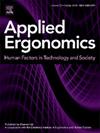真实和模拟飞行中学员和教官飞行员的个体和二元工作量评估:一项探索性研究
IF 3.4
2区 工程技术
Q2 ENGINEERING, INDUSTRIAL
引用次数: 0
摘要
飞行教官在训练新手飞行员方面是至关重要的。正如学员飞行员的心理负荷在训练过程中会有波动一样,教官的心理负荷也会有波动,从而影响他们的二元表现和判断。本文探讨了训练环境(模拟与真实飞行)、飞行控制条件(学生飞行员飞行与监控)和飞行阶段(起飞与顺风与着陆)如何影响学生和指导员飞行员的精神负荷,以及他们通过基于心电图(ECG)的测量的人际协调。学生飞行员在一名教官的指导下,在模拟器和真实飞行中,在不同的飞行控制条件和不同的工作量需求下,连续进行了四次标准的飞行交通模式,同时记录了他们的心电信号。结果表明,模拟飞行与真实飞行的人际协调模式不同。其他实验变量,即飞行控制和飞行阶段,主要影响参与者的心率和心率变异性。根据现有文献,心率在高负荷条件下和飞行阶段增加,而心率变异性降低。此外,我们观察到主观负荷与生理同步性之间存在线性关系,这表明随着学生飞行员在飞行任务中经历更多的心理负荷,学生与教官的协调性增加。目前的研究强调,通过心脏信号测量的个体工作量以及二元工作量可用于评估飞行训练期间学生-指导员的协调,作为训练结果的指标。本文章由计算机程序翻译,如有差异,请以英文原文为准。
Assessment of individual and dyadic workload of student and instructor pilots in real and simulated flight: An exploratory study
Flight instructors are vital in the training of novice pilots. Just as the mental workload in student pilots fluctuates during training, so does the mental workload of the instructors, affecting their dyadic performance and judgment. This paper explored how training environments (simulated vs. real flight), flight control conditions (student pilot flying vs. monitoring), and flight phases (take-off vs. downwind vs. landing) could affect mental workload in student and instructor pilots, as well as their interpersonal coordination through electrocardiography (ECG) based measures. Student pilots performed four consecutive standard flight traffic patterns with an instructor in a simulator and in real flight, under different flight control conditions of varying workload demands, while their ECG signals were recorded. The results indicated different patterns of interpersonal coordination between simulated and real flight. The other experimental variables, i.e., flight control and flight phase, mostly had an effect on participants’ heart rate and heart rate variability. In accordance with the existing literature, heart rate increased in high workload conditions and flight phases, whilst heart rate variability decreased. Additionally, we observed a linear relationship between subjective workload and physiological synchrony which indicates that student-instructor coordination increased as the student pilot experienced more mental workload in the flight tasks. The current study highlights that individual workload as well as dyadic workload, measured through cardiac signals, can be used to evaluate student-instructor coordination during flight training as an indicator of training outcomes.
求助全文
通过发布文献求助,成功后即可免费获取论文全文。
去求助
来源期刊

Applied Ergonomics
工程技术-工程:工业
CiteScore
7.50
自引率
9.40%
发文量
248
审稿时长
53 days
期刊介绍:
Applied Ergonomics is aimed at ergonomists and all those interested in applying ergonomics/human factors in the design, planning and management of technical and social systems at work or leisure. Readership is truly international with subscribers in over 50 countries. Professionals for whom Applied Ergonomics is of interest include: ergonomists, designers, industrial engineers, health and safety specialists, systems engineers, design engineers, organizational psychologists, occupational health specialists and human-computer interaction specialists.
 求助内容:
求助内容: 应助结果提醒方式:
应助结果提醒方式:


